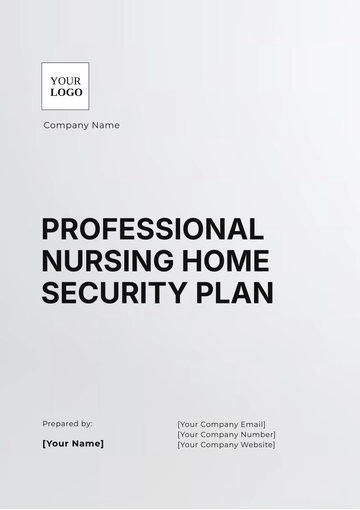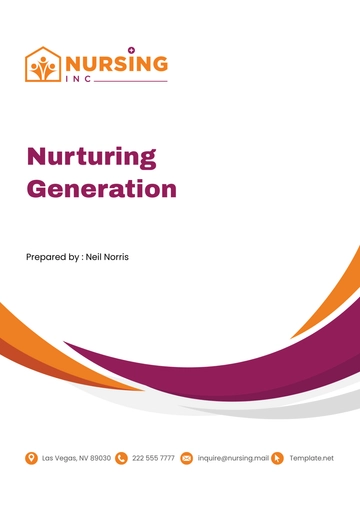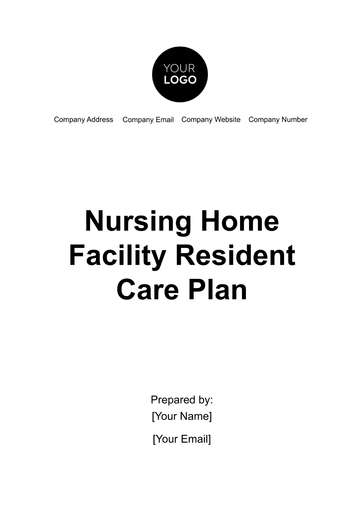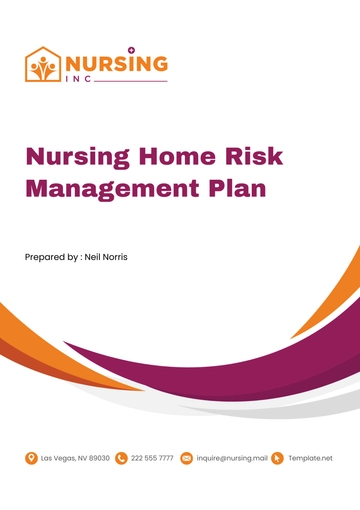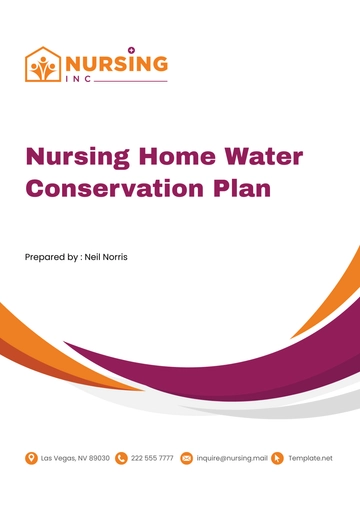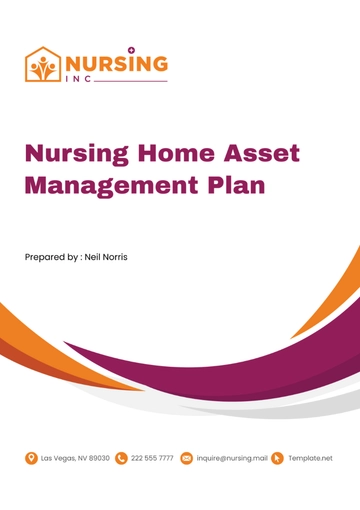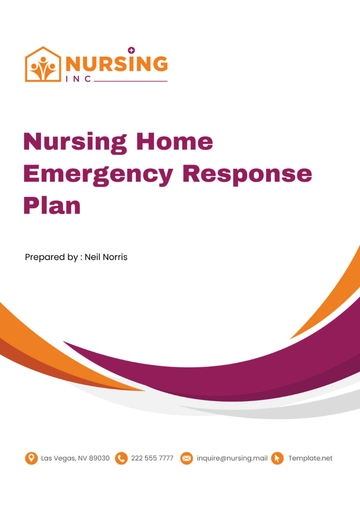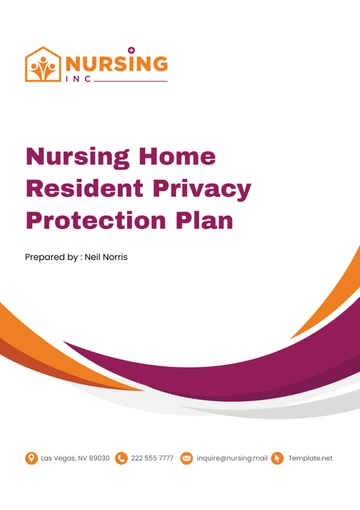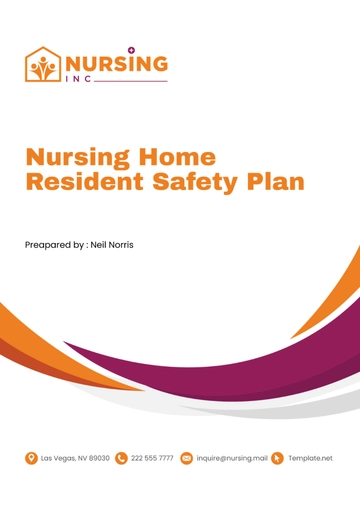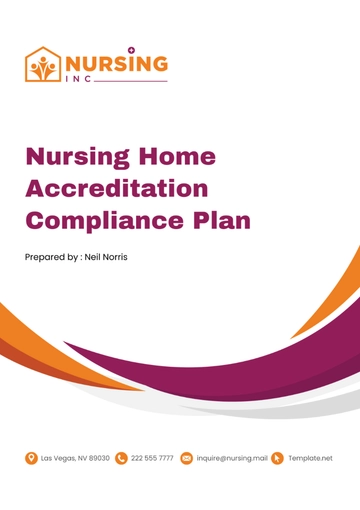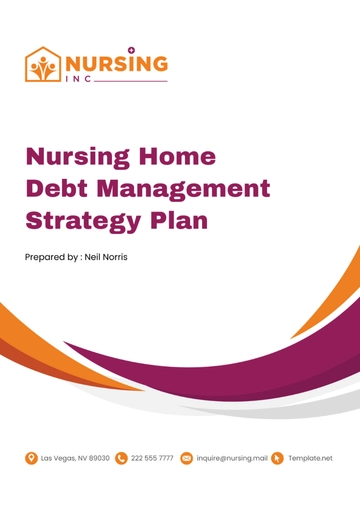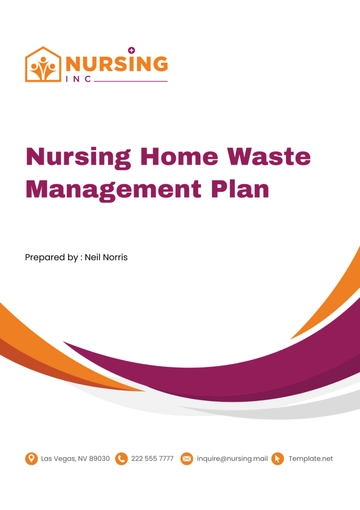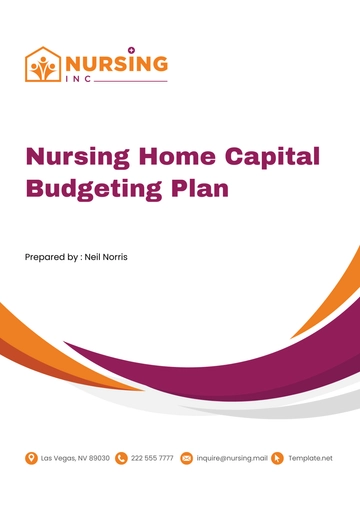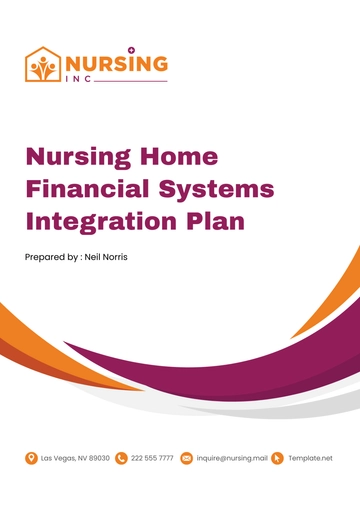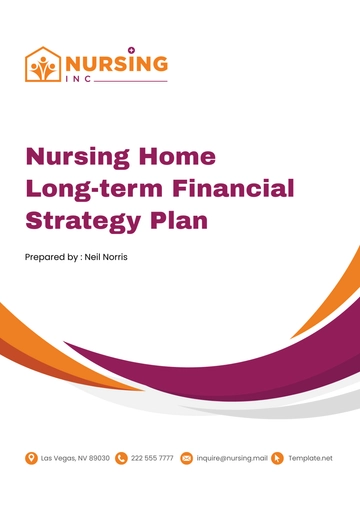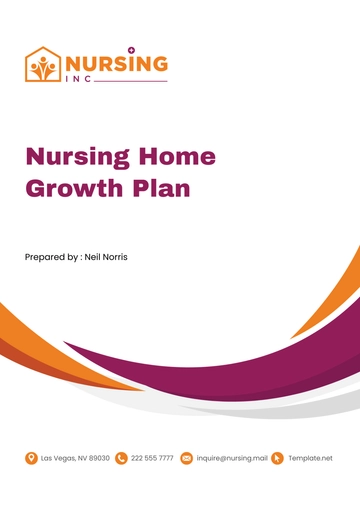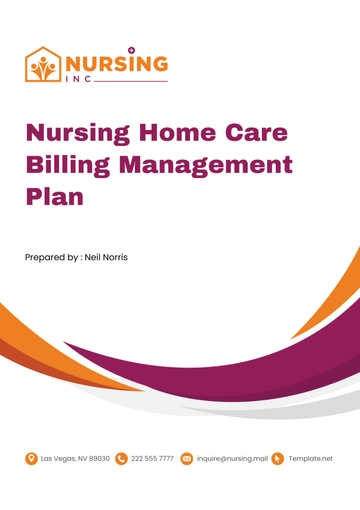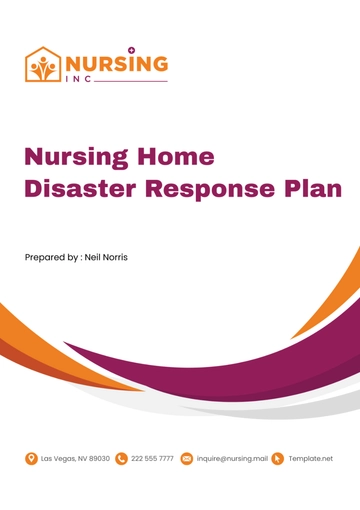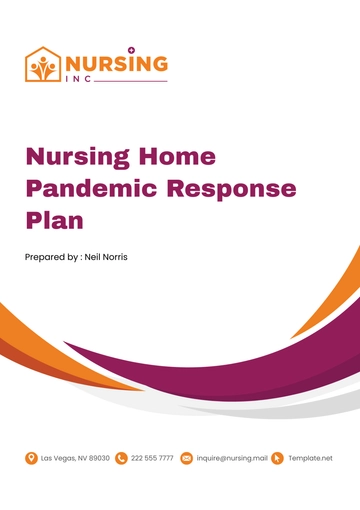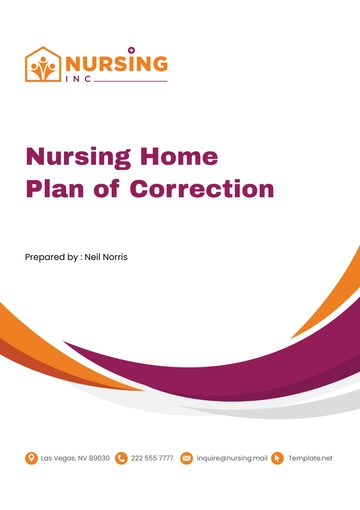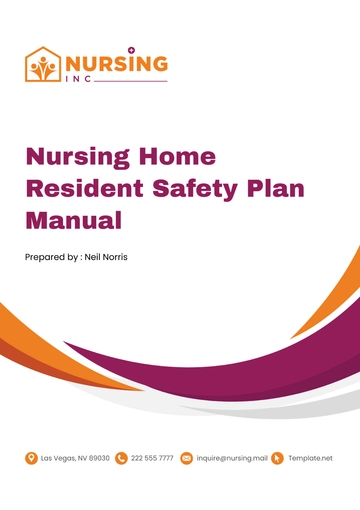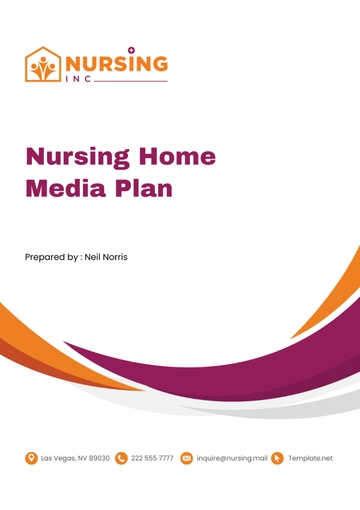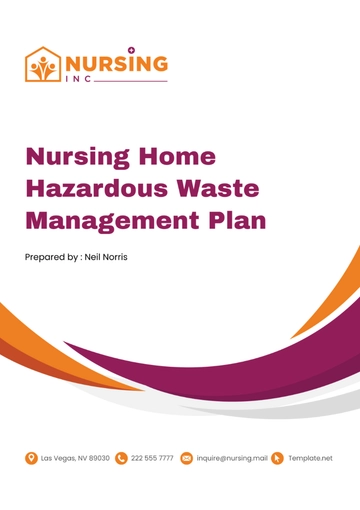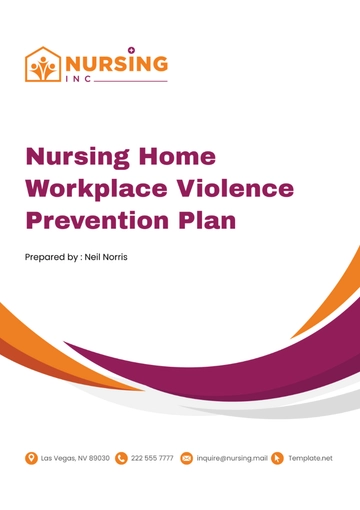Free Nursing Home Work Plan
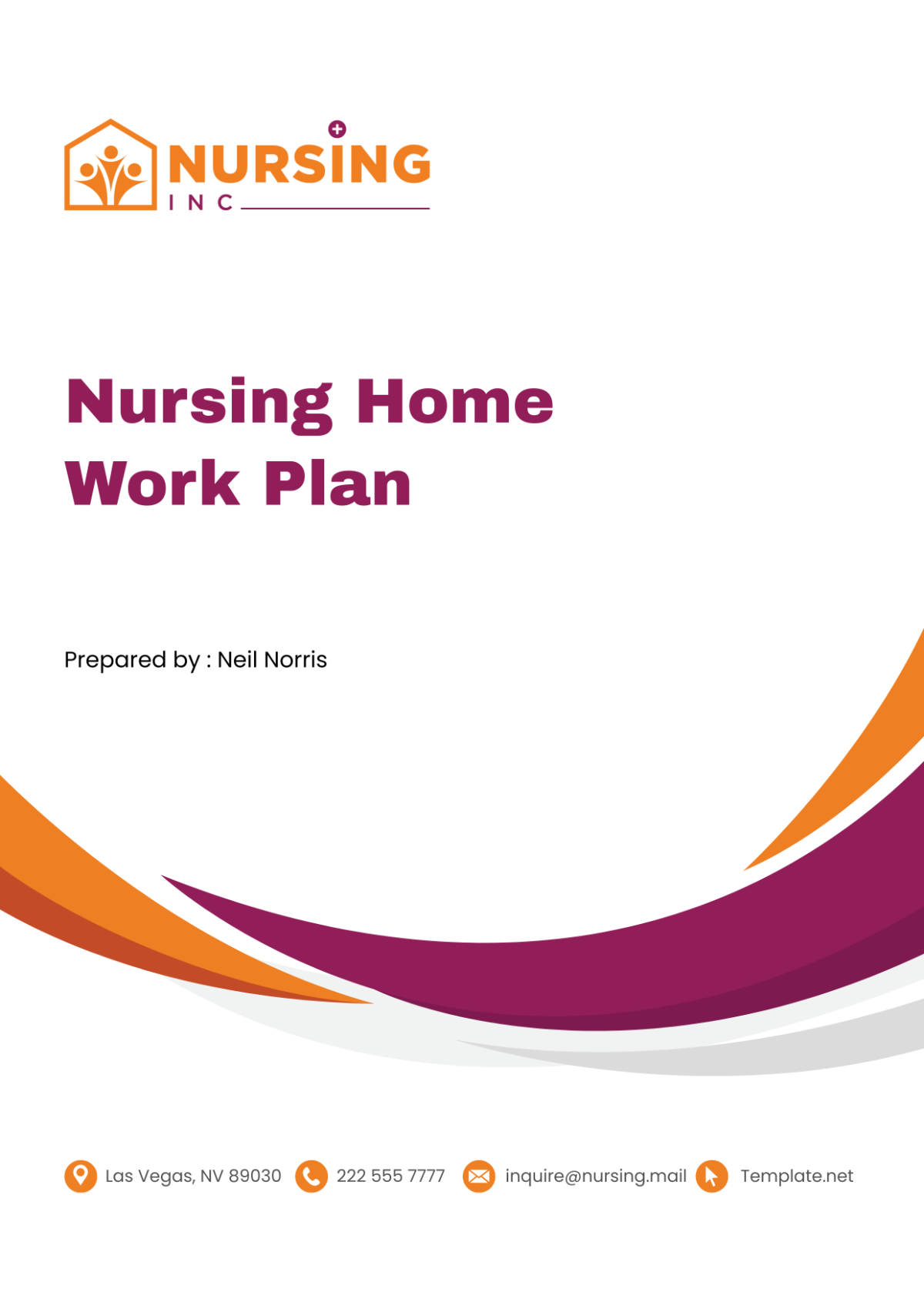
I. Introduction
A. Purpose
The purpose of this Nursing Home Work Plan is to provide a comprehensive framework for the effective management and operation of [Nursing Home Name]. By delineating roles, responsibilities, and procedures, this plan aims to ensure the delivery of high-quality care to residents while maintaining compliance with regulatory standards and promoting a safe and nurturing environment.
B. Scope
This work plan encompasses all facets of nursing home operations, including resident care, staff management, facility maintenance, administrative tasks, and emergency preparedness. It serves as a guiding document for all staff members involved in the day-to-day functioning of the nursing home.
II. Resident Care
A. Assessment and Care Planning
Task Description | Responsible Party | Timeline |
|---|---|---|
Conduct initial assessments for all residents | Registered Nurse | Upon admission |
Develop individualized care plans based on assessments | Interdisciplinary Team (including RN, LPN, and Social Worker) | Within 72 hours of admission |
Review and update care plans regularly | Interdisciplinary Team | Every 90 days or as needed based on changes in resident's condition |
Upon admission to [Nursing Home Name], all residents undergo comprehensive assessments conducted by registered nurses to evaluate their physical, cognitive, and psychosocial needs. These assessments inform the development of individualized care plans tailored to each resident's preferences and requirements.
The interdisciplinary team, consisting of registered nurses, licensed practical nurses, and a social worker, collaborates to develop care plans within 72 hours of admission. These plans outline specific interventions and goals aimed at optimizing the resident's health and well-being.
Care plans are reviewed and updated regularly, at least every 90 days or more frequently as needed based on changes in the resident's condition or preferences. The interdisciplinary team reassesses the resident's needs and adjusts care plans accordingly to ensure they remain relevant and effective.
B. Medication Management
Task Description | Responsible Party | Timeline |
|---|---|---|
Establish medication administration protocols | Director of Nursing | Upon admission |
Document medication administration and resident responses | Certified Medication Aides (CMAs) | Immediately after administration |
Conduct regular medication reviews | Pharmacist, Director of Nursing | Quarterly |
The Director of Nursing is responsible for establishing protocols for the safe administration of medications in accordance with state regulations and nursing home policies. These protocols outline procedures for medication storage, preparation, administration, and documentation.
Certified Medication Aides (CMAs) are tasked with administering medications to residents as prescribed by their healthcare providers. CMAs document each medication administered and note any observed responses or adverse reactions immediately following administration.
To ensure the safety and efficacy of medication regimens, a pharmacist collaborates with the Director of Nursing to conduct quarterly medication reviews. During these reviews, they assess residents' medication profiles for potential drug interactions, side effects, or duplications and make recommendations for adjustments as needed.
III. Staff Management
A. Recruitment and Training
Task Description | Responsible Party | Timeline |
|---|---|---|
Develop job descriptions for vacant positions | Human Resources Department | [Upon Need] |
Advertise job openings through appropriate channels | Human Resources Department | [Upon Need] |
Screen and review applications | Human Resources Department | [Upon Receipt] |
Conduct interviews and select candidates | Department Managers | [Upon Application Review] |
Conduct orientation for new hires | Human Resources Department | Within 1 week of hire |
Provide ongoing training and development opportunities | Department Managers | Ongoing |
The Human Resources Department is responsible for developing job descriptions for vacant positions based on the nursing home's staffing needs and regulatory requirements. These job descriptions outline the roles, responsibilities, and qualifications necessary for each position.
Job openings are advertised through appropriate channels, such as online job boards, local newspapers, professional associations, and recruitment agencies, to attract qualified candidates.
The Human Resources Department screens and reviews applications received for each position, ensuring that applicants meet the minimum qualifications and possess the required credentials and experience.
Department managers conduct interviews with selected candidates to assess their suitability for the position based on their skills, experience, and fit with the organizational culture.
Upon selecting candidates, department managers collaborate with the Human Resources Department to extend job offers and facilitate the onboarding process. New hires participate in orientation sessions conducted by the Human Resources Department to familiarize them with nursing home policies, procedures, and expectations.
Department managers provide ongoing training and development opportunities to staff members to enhance their skills, knowledge, and competencies. Training programs may include courses on resident care techniques, infection control practices, emergency procedures, and professional development seminars.
B. Scheduling and Staffing Levels
Task Description | Responsible Party | Timeline |
|---|---|---|
Develop staffing schedules based on resident needs | Nursing Supervisor | Weekly |
Monitor staffing levels and adjust schedules as needed | Nursing Supervisor | Daily |
Address staffing shortages through temporary staffing agencies or overtime shifts | Department Managers | [Upon Staffing Shortages] |
The Nursing Supervisor is responsible for developing staffing schedules that meet the needs of residents while adhering to regulatory staffing requirements. Schedules are created weekly and take into account factors such as resident acuity, census, and staff availability.
The Nursing Supervisor monitors staffing levels daily and adjusts schedules as needed to ensure adequate coverage for all shifts. This may involve reallocating staff, calling in additional resources, or adjusting staff assignments based on workload and resident needs.
In the event of staffing shortages, department managers collaborate with temporary staffing agencies or authorize overtime shifts to maintain appropriate staffing levels and ensure the safety and well-being of residents.
C. Performance Management
Task Description | Responsible Party | Timeline |
|---|---|---|
Establish performance expectations and job standards | Department Managers | [Upon Hire] |
Provide regular feedback and coaching to staff members | Department Managers | Ongoing |
Conduct formal performance evaluations | Department Managers | Annually |
Address performance issues and provide support for improvement | Department Managers | As needed |
Department managers are responsible for establishing clear performance expectations and job standards for staff members upon hire. These expectations are communicated effectively and aligned with the nursing home's mission, vision, and values.
Department managers provide regular feedback and coaching to staff members to recognize their achievements, address performance gaps, and support their professional growth and development. Feedback is provided in a timely and constructive manner to promote continuous improvement.
Formal performance evaluations are conducted annually to assess staff performance against established goals and job standards. These evaluations provide an opportunity for staff members to receive feedback on their performance, identify strengths and areas for improvement, and set goals for the upcoming year.
Department managers address performance issues promptly and provide support and resources to help staff members improve their performance. This may involve additional training, coaching, or mentoring, as well as disciplinary action if necessary.
IV. Facility Maintenance
A. Environmental Safety
The Maintenance Supervisor is responsible for conducting regular inspections of the facility to identify potential safety hazards and risks. These inspections cover areas such as:
Building structure: Inspection of walls, ceilings, floors, doors, and windows for signs of damage, deterioration, or structural weaknesses.
Electrical systems: Evaluation of electrical wiring, outlets, switches, and appliances to ensure compliance with safety standards and prevent electrical hazards.
Plumbing systems: Inspection of pipes, faucets, toilets, and water heaters for leaks, clogs, or other issues that may pose health or safety risks.
Based on the findings of the inspections, the Maintenance Supervisor develops and implements corrective action plans to address identified safety hazards and risks. This may involve repairs, replacements, or modifications to the facility infrastructure or systems.
In addition to routine inspections, the nursing home maintains emergency preparedness plans to address potential safety risks, such as fires, severe weather, and infectious disease outbreaks. These plans outline procedures for evacuations, sheltering in place, communication, and coordination with emergency response agencies.
B. Equipment Maintenance
The Maintenance Supervisor establishes a schedule for routine maintenance and servicing of medical equipment, assistive devices, and facility machinery. This schedule includes:
Regular inspections: Scheduled inspections of equipment to identify signs of wear, damage, or malfunction that may affect performance or safety.
Preventive maintenance: Routine maintenance tasks, such as lubrication, calibration, and cleaning, to keep equipment in optimal working condition and extend its lifespan.
Repairs and replacements: Prompt repair or replacement of faulty equipment to minimize downtime and ensure uninterrupted resident care services.
Maintenance staff members are trained on the proper use and maintenance of equipment to ensure compliance with manufacturer specifications and safety standards. Training includes instruction on equipment operation, maintenance procedures, troubleshooting techniques, and safety precautions.
The Maintenance Supervisor maintains records of equipment maintenance activities, including inspection reports, service logs, and repair records. These records document compliance with regulatory requirements, demonstrate due diligence in equipment maintenance, and facilitate traceability in the event of equipment-related incidents or audits.
V. Administrative Tasks
A. Recordkeeping and Documentation
Task Description | Responsible Party | Timeline |
|---|---|---|
Maintain electronic health records (EHR) | Health Information Management Department | Ongoing |
Document resident assessments, care plans, and interventions | Nursing Staff | Immediately |
Record significant events, incidents, and interventions | Nursing Staff, Administrative Staff | Immediately |
Ensure confidentiality and security of resident information | HIPAA Compliance Officer | Ongoing |
The Health Information Management (HIM) Department is responsible for maintaining electronic health records (EHR) for all residents. This includes:
Creating and updating resident records to reflect assessments, care plans, progress notes, and other relevant documentation.
Ensuring the accuracy, completeness, and integrity of EHR data through regular audits and quality assurance measures.
Providing secure access to EHRs for authorized staff members while maintaining confidentiality and compliance with HIPAA regulations.
Nursing staff members are responsible for documenting resident assessments, care plans, and interventions in the EHR system immediately after completion. This documentation includes:
Comprehensive assessments conducted upon admission and at regular intervals to evaluate residents' health status, functional abilities, and care needs.
Individualized care plans developed in collaboration with residents, families, and healthcare providers to address identified needs, preferences, and goals.
Documentation of interventions, treatments, medications administered, and resident responses to care interventions to ensure continuity of care and communication among interdisciplinary team members.
In addition to routine documentation, nursing staff and administrative personnel are responsible for recording significant events, incidents, and interventions as they occur. This includes:
Notifying appropriate personnel and documenting incidents such as falls, medication errors, resident injuries, or behavioral disturbances promptly and accurately.
Recording interventions implemented to address incidents, including assessments, interventions, communications with healthcare providers, and follow-up actions taken to prevent recurrence.
The HIPAA Compliance Officer is responsible for ensuring the confidentiality and security of resident information in compliance with HIPAA regulations. This includes:
Providing staff training on HIPAA policies and procedures, including privacy practices, security safeguards, and breach reporting requirements.
Conducting regular audits and assessments to monitor compliance with HIPAA standards and identify areas for improvement or corrective action.
Investigating and addressing any reported breaches or violations of HIPAA regulations, including notification of affected individuals, regulatory agencies, and other stakeholders as required.
VI. Conclusion
A. Continuous Improvement
Task Description | Responsible Party | Timeline |
|---|---|---|
Conduct quality improvement (QI) initiatives | Quality Improvement Committee | Ongoing |
Solicit feedback from residents, families, and staff members | Administration, Resident Council, Staff Meetings | Regularly |
Implement process improvements based on feedback and QI findings | Department Managers, Quality Improvement Committee | As Needed |
The Quality Improvement (QI) Committee is responsible for leading and coordinating quality improvement initiatives to enhance the overall quality of care and services provided at [Nursing Home Name]. This includes:
Identifying opportunities for improvement through data analysis, performance monitoring, and feedback from residents, families, and staff members.
Developing and implementing action plans to address identified areas for improvement, such as reducing medication errors, improving resident satisfaction, or enhancing infection control practices.
Monitoring the effectiveness of QI initiatives through ongoing data collection, measurement, and evaluation to ensure sustained improvements in resident outcomes and organizational performance.
[Nursing Home Name] actively solicits feedback from residents, families, and staff members to identify opportunities for improvement and ensure alignment with resident preferences and expectations. This feedback is gathered through various channels, including:
Resident and family satisfaction surveys conducted regularly to assess perceptions of care quality, communication, and overall satisfaction with services.
Resident council meetings, family forums, and staff meetings where feedback and suggestions for improvement are solicited, discussed, and addressed.
Informal feedback mechanisms such as suggestion boxes, comment cards, and open-door policies that encourage open communication and engagement among stakeholders.
Based on feedback received and QI findings, department managers and the QI Committee collaborate to implement process improvements and best practices that enhance resident care and organizational efficiency. This may include:
Revising policies, procedures, and protocols to reflect best practices and incorporate resident preferences and feedback.
Providing additional staff training and resources to address identified areas for improvement and promote a culture of continuous learning and excellence.
Monitoring the impact of process improvements through ongoing performance measurement and evaluation to ensure sustained progress and positive outcomes for residents and stakeholders.
- 100% Customizable, free editor
- Access 1 Million+ Templates, photo’s & graphics
- Download or share as a template
- Click and replace photos, graphics, text, backgrounds
- Resize, crop, AI write & more
- Access advanced editor
Streamline nursing home operations with the Nursing Home Work Plan Template from Template.net. Editable and customizable, it simplifies the process of outlining tasks, timelines, and responsibilities. Tailor it effortlessly using our Ai Editor Tool for personalized work plans. Simplify your planning process and ensure efficient task management with this essential template.
You may also like
- Finance Plan
- Construction Plan
- Sales Plan
- Development Plan
- Career Plan
- Budget Plan
- HR Plan
- Education Plan
- Transition Plan
- Work Plan
- Training Plan
- Communication Plan
- Operation Plan
- Health And Safety Plan
- Strategy Plan
- Professional Development Plan
- Advertising Plan
- Risk Management Plan
- Restaurant Plan
- School Plan
- Nursing Home Patient Care Plan
- Nursing Care Plan
- Plan Event
- Startup Plan
- Social Media Plan
- Staffing Plan
- Annual Plan
- Content Plan
- Payment Plan
- Implementation Plan
- Hotel Plan
- Workout Plan
- Accounting Plan
- Campaign Plan
- Essay Plan
- 30 60 90 Day Plan
- Research Plan
- Recruitment Plan
- 90 Day Plan
- Quarterly Plan
- Emergency Plan
- 5 Year Plan
- Gym Plan
- Personal Plan
- IT and Software Plan
- Treatment Plan
- Real Estate Plan
- Law Firm Plan
- Healthcare Plan
- Improvement Plan
- Media Plan
- 5 Year Business Plan
- Learning Plan
- Marketing Campaign Plan
- Travel Agency Plan
- Cleaning Services Plan
- Interior Design Plan
- Performance Plan
- PR Plan
- Birth Plan
- Life Plan
- SEO Plan
- Disaster Recovery Plan
- Continuity Plan
- Launch Plan
- Legal Plan
- Behavior Plan
- Performance Improvement Plan
- Salon Plan
- Security Plan
- Security Management Plan
- Employee Development Plan
- Quality Plan
- Service Improvement Plan
- Growth Plan
- Incident Response Plan
- Basketball Plan
- Emergency Action Plan
- Product Launch Plan
- Spa Plan
- Employee Training Plan
- Data Analysis Plan
- Employee Action Plan
- Territory Plan
- Audit Plan
- Classroom Plan
- Activity Plan
- Parenting Plan
- Care Plan
- Project Execution Plan
- Exercise Plan
- Internship Plan
- Software Development Plan
- Continuous Improvement Plan
- Leave Plan
- 90 Day Sales Plan
- Advertising Agency Plan
- Employee Transition Plan
- Smart Action Plan
- Workplace Safety Plan
- Behavior Change Plan
- Contingency Plan
- Continuity of Operations Plan
- Health Plan
- Quality Control Plan
- Self Plan
- Sports Development Plan
- Change Management Plan
- Ecommerce Plan
- Personal Financial Plan
- Process Improvement Plan
- 30-60-90 Day Sales Plan
- Crisis Management Plan
- Engagement Plan
- Execution Plan
- Pandemic Plan
- Quality Assurance Plan
- Service Continuity Plan
- Agile Project Plan
- Fundraising Plan
- Job Transition Plan
- Asset Maintenance Plan
- Maintenance Plan
- Software Test Plan
- Staff Training and Development Plan
- 3 Year Plan
- Brand Activation Plan
- Release Plan
- Resource Plan
- Risk Mitigation Plan
- Teacher Plan
- 30 60 90 Day Plan for New Manager
- Food Safety Plan
- Food Truck Plan
- Hiring Plan
- Quality Management Plan
- Wellness Plan
- Behavior Intervention Plan
- Bonus Plan
- Investment Plan
- Maternity Leave Plan
- Pandemic Response Plan
- Succession Planning
- Coaching Plan
- Configuration Management Plan
- Remote Work Plan
- Self Care Plan
- Teaching Plan
- 100-Day Plan
- HACCP Plan
- Student Plan
- Sustainability Plan
- 30 60 90 Day Plan for Interview
- Access Plan
- Site Specific Safety Plan

